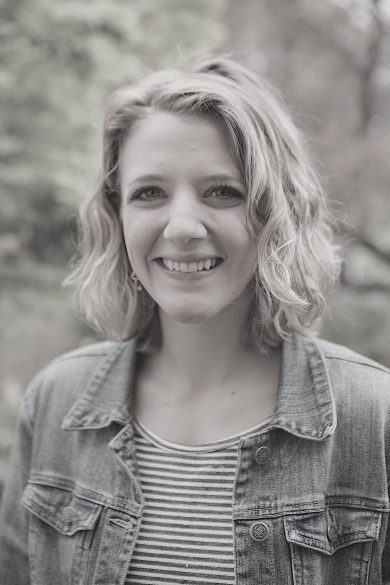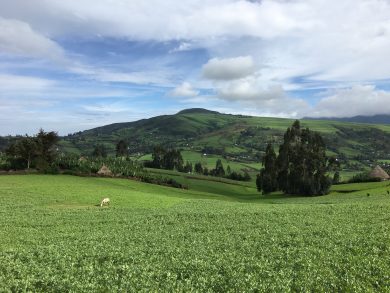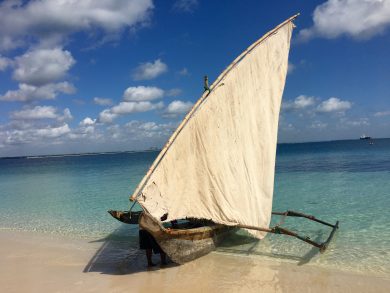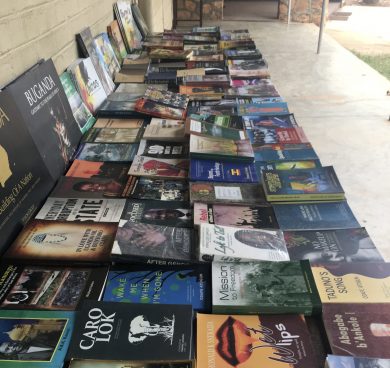Graduate Profile: Kelsey McFaul, Literature Doctoral Student

Kelsey McFaul is a PhD Candidate in the Literature Department at UC Santa Cruz. Her core research interests lie in African literature, environmental humanities, and the Indian Ocean world. This year, McFaul was selected as a year-long THI Public Fellow and has been working closely with the Center for the Art of Translation in this capacity.
In January, we spoke with McFaul about her research and experience so far as a THI Public Fellow. We learned about the intersection of her scholarly work and the mission of the Center – each of which focuses on major questions in the history of African literary culture. More broadly, McFaul walked us through the ins-and-outs of the contemporary publishing landscape for such work and the role of place-making in the literature she studies.
Thanks for taking the time to speak with us Kelsey! To help ground our conversation, would you mind just telling us in broad strokes about your research interests? How do you think about your scholarship?
Thank you so much for the invitation! Broadly I study African literature, and my dissertation research focuses on novels in the Horn of Africa from the 20th century to the present as they construct a shared sense of place across uneven experiences of European and regional empire. I am also interested in the ways that environments and geographies are used to naturalize projects of ethnicity- and race-making. I see my scholarship contributing to and extending thinking about the Horn of Africa as a regional space even as it challenges categories like nation and language which typically organize our study in the humanities and African Studies. It’s also my hope that by studying the African novel in a region with such rich literary traditions in oral culture and African languages, this scholarship can help us revisit the question of what language the African writer should write in with greater specificity. To all of this, I also bring an interest in environmental humanities, comparative ocean studies, and language study in Amharic.
Your focus on the novel, place-making, and empire is absolutely fascinating. Working through such big ideas in your own scholarly work sounds both challenging and extremely important. Can you give us something of an overview of what you’re working on in your dissertation? What’s at stake in this project?
In my experience, most readers’ knowledge of African literature is composed of English-language novels organized by nation. From this perspective, it seems like Chinua Achebe’s argument that the “English language will be able to carry the weight of my African experience” has won out over Ngũgĩ wa Thiong’o’s view that “African literature can only be written in African languages.” But this debate doesn’t really account for the uneven experiences of British and other European forms of colonialism in Africa, and it also leaves out significant nuance within African language politics and their respective literary traditions. A lot of my work aims to show that Horn of Africa writers are navigating slightly different concerns: not whether to write in a European language but which one; whether to write in their mother tongue or in a more widely spoken regional language; whether to compose poetry or prose.

My project studies the history of the novel in the Horn of Africa—the geography we know today as Djibouti, Eritrea, Ethiopia, Somalia, and Somaliland—by reading works composed in English, French, Italian, and Amharic in relation with one another. In this entangled regional approach, the borders and categories of knowledge that have been applied here appear fantastical. What emerges instead is a literature embedded in a particular relationship to place—highlands and lowlands, mountainous interiors and arid coasts—and seasonal time, across which flow the influences of two world religions, a regional power with its own imperial language, multiple forms of metropole education, and an infusion of socialist realist texts in translation. My dissertation calls attention to the interwoven nature of this regional literary tradition (without attempting to disentangle or overly interpret it!) and the ways the novel form arises from and addresses its complexities.
In addition to the Horn of Africa’s internal literary connectedness, I’m also interested in its connections to the larger world through the vectors of the African diaspora and comparative oceans. In contrast to West Africa, the Horn of Africa and Ethiopia in particular don’t enter into vectors of Black Atlantic slavery but occupy a mythic status (itself largely an invention) as a site of diasporic return. Ideas of Africa within Black speculative fiction in the Americas, as well as in African speculative fiction on the continent, formed the basis of my Summer 2020 literature course “African Futurisms.” Of course histories of enslavement, as well as other forms of forced and free migration, do stretch from the Horn of Africa eastward across the Red Sea and Indian Ocean world; this has been the focus of my work in the Feminist Futures in the Indian Ocean working group and in my recent peer-reviewed article in the Journal of Indian Ocean World Studies.
This year you’ve been working as a THI Public Fellow with the Center for the Art of Translation. What do you want readers to know about the Center? What is their mission, and why do you find it so important?
My research relies on translation (my own and others’), so I understand how time-consuming and deeply valuable literary translation is. Consequently, I have a deep love and respect for the Center for the Art of Translation’s work! For a long time, translators’ names were left off the material they translated. Even today, they are rarely considered creators in their own right (see #namethetranslator) or given proper credit or compensation. Olivia Sears, an editor and translator from Italian, founded the Center in 2000 to challenge this trend. Olivia had started publishing a literary journal of en face (side-by-side) translations in 1993 and deepened and expanded her vision with the Center, which creates venues for translators to publish their work and discuss their craft while building audiences for translated literature. Today, Two Lines Press, a program of the Center, publishes six translated novels a year in addition to two thematically curated Calico journals and an online journal. Two Lines publishes beautiful editions and some of my most absolute favorite novels in translation (Marie NDiaye’s Self-Portrait in Green translated by Jordan Stump, and Johannes Anyuru’s They will drown in their mother’s tears translated by Saskia Vogel), so I was a huge fan before my fellowship even began! In my time here so far, my admiration for the thoughtfulness and artistry of their work has only grown.
Another wonderful part of the Center’s work is Poetry Inside Out, a collaborative language arts curriculum for primary and secondary school teachers seeking to incorporate translation in their classrooms. I love Poetry Inside Out because it treats cultural and linguistic difference as assets rather than barriers to learning and introduces students to literature around the world. I wish that I’d encountered a language arts class like this when I was younger!
From our understanding, you’ve been doing a number of different things as a Public Fellow with the Center. What are some of the most interesting projects or activities that you’ve been working on in this capacity?
My work with the Center falls into two categories. First, I have a range of editorial tasks including reading submissions, participating in editorial board meetings, and conducting marketing and sales research. In the background, I’m also reading the press’ backlist of published work, our upcoming publications, and similar work published by other small literature in translation presses and online platforms. I feel incredibly fortunate to devote time to reading and discussing translated literature with such thoughtful fellow readers and learning the ins and outs of the independent publishing world and the book publishing industry more broadly. While sadly my Public Fellow experience has existed in virtual space, I’m incredibly grateful for the ways my mentor and everyone at the Center have welcomed me so warmly into their team and culture.

My second task is gathering information about folks translating African language literature into English. To me, one of the most important qualities of this literature is that its stories, techniques, and voices are modulated primarily for African readers (Western readers are just a bonus). The Center is always keen to support contemporary African literature (in addition to Anyuru, Two Lines also published Igiaba Scego’s Beyond Babylon translated by Aaron Robertson in 2019) and has a special interest in Kiswahili, a Bantu language spoken as a first or second fluent language in much of East Africa (an official language in Tanzania and Kenya, Kiswahili is also spoken in Uganda, Rwanda, and the Democratic Republic of the Congo, not to mention the global diaspora). There’s a rich literary tradition in Kiswahili stretching three centuries or more but relatively little of this literature has been translated, at least in forms available outside of East Africa.
On behalf of the Center, I’ve reached out to Kiswahili translators around the world about their ongoing projects, the difficulties they encounter, and their visions for the future of Kiswahili literature in translation. In addition to contemporary writing in Kiswahili championed by the Mabati-Cornell Kiswahili Prize for African Literature, one of the first pan-African literary prizes for an African language, I’ve learned of many exciting translation projects from Kiswahili to English and the opposite direction. Jalada Africa has collected 95 translations, including one in Kiswahili, of an Ngũgĩ wa Thiong’o short story and the Hekaya Arts Collective hosts an annual Swahili Literature Festival in Mombasa, Kenya. I’ve also learned of collaborative translation groups and translations between different Kiswahili dialects and between Kiswahili and Arabic. It’s my hope that the Center will be able to partner with and support some of these projects in the future.
THI public fellows often work on projects which exist in relation to key aspects of their research interests or intellectual orientations. How has your experience in this role interfaced with your scholarly interests?
My work with the Center as a Public Fellow, generously supported by The Humanities Institute, intersects with my academic research in more ways than I could have possibly imagined! Thanks to my research in African literature, I have a working knowledge of the literary landscape in East Africa and some background in Kiswahili literary history as it interfaces with other literary traditions in the region. This has informed my conversations with the press and given me useful leads on where to seek out literature in translation. Reading online African literary journals like Jalada, Hekaya, Lolwe, and Down River Road, which I do for my own work, also introduced me to exciting contemporary writers and translators in Kiswahili. There are also serendipitous intersections, like an upcoming novel from the Indian Ocean island of Mauritius and a project researching francophone Caribbean translators. My work as a Public Fellow has also connected me to new academic-translator networks, motivated me to pursue my own translation projects, and created spaces to converse with writers about books we both love and the state of possibility for African literature. In a time when research travel is impossible, these forms of connection have been so rewarding.

More broadly, the Euro-American publishing industry assumes that only certain versions of African stories are legible to readers, and I see my academic and personal work involved in dismantling the structures underlying that assumption. For those of us who love and study African literature, the recent critiques and studies of systemic whiteness and discrimination against writers and workers of color within the U.S. book industry are no surprise. The Center is also actively taking up these conversations and decisions, and my time in editorial board meetings has taught me that those who care about literature in translation share similar values and goals. Working as a Public Fellow has given me the space and skills to begin enacting these values in tangible ways. Moreover, I’ve noticed that independent presses take “risks” in large part because they build relationships with and believe in their readers. While the publishing industry and those of us who work in it certainly have a long way to go, this relational quality makes me optimistic about the future of African literature in African languages, in translation, and in English.
